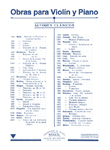Cor vol. IV
Clar de Lluna
Coro mixto
CASALS, Pau; CASALS, PabloReg.: BC0013
21,20 €
P.V.P. (VAT included 4%)
Add to cart
- Arrangement: COHÍ I GRAU, Agustí
- Review: CASALS ISTOMIN, Marta
- Ensemble: Symphonic band.
Choir: ; Mixt. - Genres: Classical / contemporary: Arrangements and Transcripts; Choir.
- Lyric author: RAMON I VIDALES, Jaume
- Language: Catalán
- Product format: Partitura
- Difficulty level: Intermediate
- Period: 1st half S. XX
- Publishing house: Editorial Boileau
- Collection: Pau Casals
- No. of pages: 44
- Measure: 32,00 x 23,00 cm
- Lenght: 7'30"
- ISBN: 978-84-17199-93-7
- ISMN: 979-0-3503-4317-9
- Available in digital: No
- Available for rent: No
A work for male chorus (or in this edition for mixed chorus in a version by Agustín Cohí y Grau) based on a text by Jaume Ramon y Vidales dated 1896.
The original manuscript of this work contains 31 pages and is preserved in the archive of the Clavé chorus Lira Vendrellense, the choral group to which Casals dedicated the work. On the cover the dedication and title appear as: «Als meus amics de La Lira amb molta afecció. [To my Friends of The Lira with much affection.] Pau Casals » along with the title: «Clar de lluna, coro á 4 veus escrit expressament per la Lira Vendrellense i dedicat á la mateixa per sos autors, música de Pau Casals / lletra de Jaume Ramon» [Moonlight, for 4 voice chorus, composed expressly for La Lira Vendrellense and dedicated to that chorus by the authors of the work, music by Pau Casals / text by Jaume Ramon.] Although the cover indicates the date as 1897, at the end of the work, the composer wrote the actual date of completion: «96/97 abril» [96/97 April]. This style of dating would later become customary for Casals. The score preserved in the Casals Archive indicates «Barcelona, 1896».
The work was conceived as a romance, a literary genre which normally exhibits a certain connection to Nature combined with dramatic qualities, such as was seen in works by Clavé. Clearly, Casals was very familiar with the musical aspects of that repertoire as can be clearly observed in this work which utilizes some of the same techniques found in Clavé’s music--such as the low voices singing with a closed mouth so as to highlight the high voices, the simplicity of the melodic development along with the harmonies and prolonged note values. Occasionally Casals uses passing chromaticism which gives color and also complicates the performance of the composition.
Composed in the key of E Flat Major, the time signatures of 6/8 and 9/8 give the work a dance-like quality. The piece is divided into seven movements with a poetic character: Allegretto tranquillo in E Flat Major, Andante in the same key, Allegretto in F Major, Allegro with modulating passages which end in d minor, Largo in G Major, Andante in E Flat Major, and finally, Viu [Vivo] in the same key.
The author of the text, Jaume Ramon y Vidales (1847-1900), a writer trained as a lawyer, worked as a Notary in Sarral, Montblanc and El Vendrell. A committed advocate of the Catalan cultural movement known as the Renaixença [Renaissance], he was one of the founders of Jove Catalunya and highly encouraged Guimerà to write in Catalan. He collaborated in publications such as La Renaixença, Lo Gay Saber and La Ilustració Catalana, among others. In 1890 he founded and also directed El Vendrellense, where his series Vendrell historic was later published in 1933. Principally he wrote poetry, literary prose and dramas with a popular character.
1. Pau Casals, apunt biogràfic / Pau Casals, biographical notes / Pau Casals, apunte biográfico
2. Criteri de l’edició / Criteria for the publication / Criterio de la edición
3. Criteri de la documentació i catalogació / Documentation and cataloguing criteria / Criterio de la documentación y catalogación
4. Introducció a l’obra / Introduction to the work / Introducción a la obra
5. Partitures / Scores / Partituras:
Clar de lluna
6. Catàleg / Catalog / Catálogo








